
by Elizabeth Hines | Jan 16, 2019 | Blog, Content Marketing, Logistics, Marketing, Supply Chain
Updated February 4, 2025
Digital marketing for the supply chain has become necessary to position your company to not only be found online, but also to be researched and to be compared to your competition.
Highlights:
- Digital marketing uses your website, related social media, and other online industry channels to showcase your industry knowledge and experience.
- Thought leaders are the informed trusted sources in their field of expertise.
- Supply chain and logistics industries need content marketing to achieve confidence and relationship-building with buyers.
Today’s B2B buyers are researching, evaluating, and coming to conclusions about companies without a single contact with a team member or salesperson.
This kind of B2B buying landscape requires cutting edge marketing strategies to showcase nut-and-bolt industries that have survived without them for many years.
Digital marketing for the supply chain
Digital marketing for the supply chain uses your website, related social media, and other online industry channels to showcase your industry knowledge and experience (rather than trying to convince people of it with a marketing message).
With inbound digital marketing, you publish relevant, informative information to adds value to every stage of a potential customer’s buying journey.
It is the content that you publish that walks them through the initial stages of the sales process.
What should you publish? A good content marketing strategy is about understanding the questions and concerns that are particular to your customer base, and offering quality information and analysis that answers those needs.
Showcasing thought leadership through digital marketing
Discovering and meeting the needs of your customers that go beyond your products and services will catapult you in their minds as a knowledgeable, helpful “thought leader” in your industry.
Thought leaders are the informed trusted sources in their field of expertise. They have innovative ideas, can showcase their thinking, and can replicate their successes again and again.
Consider it: Your business has so much more to offer than its primary product or service. You have a team of people with a tremendous aggregate of experience, expertise, and perspectives.
Allowing your customers this sort of access to your team’s experience and knowledge provides them with tremendous value outside the sales funnel, which builds trust and cultivates lasting, fruitful relationships.
Why digital marketing?
In this B2B buying landscape, supply chain and logistics industries need content marketing to achieve a level of confidence and relationship-building with buyers that used to come from face-to-face meetings. Potential and current customers will view your company as a valuable resource for everything related to not only your products and services but to the industry as a whole.
No time to execute?
The downside? Content marketing requires significant time, labor, and resources, and it can take quite some time to start reaping benefits. Feeling overwhelmed and like you and your team can’t possibly add on more marketing? Outsourcing certain key marketing tasks allows insourcing your core competencies while delegating specialized tasks to external experts.
This post originally appeared on EBN Online.
Related posts:

by Fronetics | Jan 10, 2019 | Blog, Content Marketing, Marketing, Supply Chain
With the start of the new year, it’s time to take a breath and get ready for what’s next. Here are five trends in supply chain marketing to expect in 2019.
Highlights:
- People trust people, not ads.
- Knowing how your customers communicate is key.
- Personal connection is the key to success.
There are a lot of sales and marketing speakers already shouting out the trends for 2019. It’s a fast-paced world, and it can be tough to tune out the noise and maintain your identity in the constantly shifting marketing landscape.
The best way to navigate all the changes and trends is to plan ahead and be aware of what’s in the pipeline. Here are five supply chain marketing trends to be on the lookout for in 2019.
1) People trust people, not ads.
We know that traditional, outbound marketing is falling out of favor, making way for inbound techniques to take the lead. In fact, a Nielsen study from nearly four years ago found that the four most trusted sources of advertising were (1) people you know, (2) branded sites, (3) editorial sites, and (4) reviews.
[bctt tweet=”A Nielsen study from nearly four years ago found that the four most trusted sources of advertising were (1) people you know, (2) branded sites, (3) editorial sites, and (4) reviews.” username=”Fronetics”]
With ad blockers on the rise and this continued cultural shift towards inbound marketing, supply chain marketers need to tailor their efforts towards creating reliable, relevant content that will be of value to their customers.
2) Creativity is the wave of the future
We’ve written before about the increasing need for creative thinking in the supply chain. It’s no different when it comes to marketing the supply chain. The age of conformity is over (if it ever really existed in the first place). With so many players on the field, the ones who will really stand out in the coming years are those who think outside the box.
While we can’t tell you how to be creative, remember that content marketing, at its core, is about telling stories. Take a step back and think about your brand, its story, and what it means to your audience — then get ready to brainstorm!
3) Successful businesses will focus on breaking down internal divisions.
We’re always amazed by the persistent fear that content marketing is somehow the enemy of sales teams. In fact, we’ve written frequently about the symbiotic relationship between marketing and sales, and the need for alignment between the two departments.
Increasingly, supply chain companies need synergy between sales and marketing to be successful. In a recent article in Forbes, Calendar co-founder and President John Hall writes, “companies that put up barriers between departments will fail in the long run.” We agree. Hall goes on to point out that “great content can fuel other parts of the company, resulting in better talent, lower costs, and improved relationships with investors.”
4) Knowing how your customers communicate is key.
It’s easy to forget how quickly communication has changed over the past several decades. While life before cell phones is a dim memory, it’s important to remember that the ways in which we communicate with each other as individuals and as businesses continue to evolve.
For content marketing efforts to be successful, supply chain companies need to be keenly aware of how their target buyers are interacting, and they need to be ready to meet their buyers where they are. Keep a finger on the pulse through social media, and continue to evaluate and refine how well your content is reaching and resonating with your target audience.
5) People haven’t really changed that much.
Ok, so we’ve been telling you about all of the seismic cultural shifts brought about by technology, and all of the ways that marketing has changed over the past decade, and now this? Well, at the end of the day, people are still people, and they value helpfulness, authenticity, and relationships.
Luckily, that’s what good content marketing is all about. As technology and automation continue to progress, it’s crucial to remember the point of it all: personal connections and communication of trustworthy, valuable information.
Related posts:


by Fronetics | Jan 8, 2019 | Blog, Content Marketing, Logistics, Marketing, Strategy, Supply Chain
Before you make your marketing resolutions for this year, take a moment to look at last year’s digital content marketing successes and failures.
As the new year begins, take the opportunity to look at past marketing choices, see what worked and what didn’t, and shape goals for the future. The year ahead is a blank canvas, but evaluating past successes and missteps is key to making sure the big picture works.
Writing for Forbes Communication Council, Senior Digital Marketing Manager at Caring People Inc. Karina Tama-Rutigliano offers these four tips for successfully moving forward with digital marketing.
1) Don’t go anywhere without clear, specific goals — and a plan for measuring results.
Assuming you’ve been tracking useful metrics along the way, the end of the year means you’re armed with a fresh crop of data. Take time to study and evaluate your data, and use it to develop incremental goals, as well as projections for next year. If you haven’t already, now is a good time to implement a documentation strategy, like our Monthly Marketing Report Template.
Furthermore, take a moment to consider how the metrics you’re currently tracking are serving you. Is your data giving you the insights you need? Are you left with questions about where your efforts are successful, or where another approach is needed? The beginning of the year is a good time to tweak your plan for tracking and measuring the results of your digital marketing efforts.
2) Don’t forget the “social” in social media.
[bctt tweet=”Social media platforms are viable places to engage with your customers,” writes Tama-Rutigliano. This means encouraging interaction with your posts, replying to comments, and engaging with posts from your community.” username=”Fronetics”]
You’re so busy creating and curating content to be fresh, relevant, and engaging for your social media audience, you forget that one crucial part of social media marketing: the social. “Social media platforms are viable places to engage with your customers,” writes Tama-Rutigliano. This means encouraging interaction with your posts, replying to comments, and engaging with posts from your community — be part of the conversation, and build relationships.
3) Don’t put all your eggs in one basket.
With so many options for digital marketing, all of them full of possibilities, it can be tempting to choose one or two and put all your dollars and efforts there. But a successful digital content marketing strategy is robust and well-rounded. Use your year-end data to evaluate where your efforts are thriving, and where you need to devote some cash and ideas.
4) Don’t post without a purpose.
We’ve all felt the push to create content, just for the sake of getting something new up on the blog or social media platforms. But content without a clear purpose in mind is never going to get you the best results.
It’s easy to get cynical, and think that content creation is just about feeding the search engine beast. But the heart and soul of content marketing is about sharing your knowledge and expertise with your customer-base, building trust, and creating lasting relationships.
Related posts:


by Fronetics | Dec 18, 2018 | Blog, Content Marketing, Logistics, Marketing, Supply Chain
Aligning sales and marketing can help achieve big-picture goals. Here are the top five sales and marketing posts of 2018 that highlight how these two teams can work together.
The sales process is often a complicated journey that includes uphill climbs and unexpected roadblocks. Sales teams are all too familiar with these obstacles, but they don’t have to fight these battles alone.
Arm a sales rep with targeted content to share with prospects during specific moments in the purchasing process, and it will build his or her reputation as a knowledgeable resource. That can be the key to getting a foot in the door, advancing through the final stages of a purchasers’ decision, or closing the deal.
[bctt tweet=”Arm a sales rep with targeted content to share with prospects during specific moments in the purchasing process, and it will build his or her reputation as a knowledgeable resource. ” username=”Fronetics”]
Strong communication between sales and marketing can help create better content and nurture leads. Here are our top five sales and marketing posts of 2018.
Top 5 sales and marketing posts 2018
1. Infographic: the B2B Buyer’s Journey
Technology has completely changed the B2B buyer’s journey. The vast amount of information available on the internet has afforded buyers a level of self-sufficiency that renders traditional sales models ineffective. Marketers must leverage the latest trends and technologies to boost their content marketing efforts and turn leads into sales. Here are nine factors affecting today’s B2B buying journey. Read full post
2. Infographic: How Digital Natives are Changing B2B Purchasing
Long gone are the days of men and women sitting around a conference table listening to a sales pitch over a free lunch. Today’s B2B buyers are younger, more technologically savvy, and more independent — they’re a generation of digital natives. And they’re making waves across the B2B buying landscape and changing how marketers must work to reach new customers. Here’s what you need to know about the new B2B buyer. Read full post
3. The 3 Most Important Sources of Information for B2B Buyers
From a content marketing perspective, knowing where your buyers get their information is critical to an effective strategy. So what are most important sources of information for today’s B2B buyers? 20 years ago, you might have named things like product info sheets or sales reps. But not anymore. Read full post
4. 3 Dangers of Sales and Marketing Misalignment
Too often, B2B companies fall victim to the dangers of sales and marketing misalignment, often without even being aware that it’s an issue. Such misalignment can have serious motivational and financial consequences. These are the major dangers of sales and marketing misalignment compared to what can happen when things go right. Read full post
5. Infographic: Delivering Content Throughout the Buyer’s Journey to Help Your Sales Team Close Deals
If you’re a supply chain marketing professional, it’s likely that you spend a tremendous portion of your day researching, creating, packaging, and disseminating content. It’s time to start leveraging your it throughout the buyer’s journey by arming your sales force with content. Before you panic at the idea of creating reams of new content, take a breath. It’s more than likely that you can repurpose your existing content, optimized to give your sales force the tools they need to close deals.Read full post
Related posts:


by Fronetics | Dec 4, 2018 | Blog, Content Marketing, Logistics, Marketing, Strategy, Supply Chain
Repurposing content is an efficient way to reach a broader audience and build brand awareness.
You spent hours pouring over stats and interesting facts for a blog post. Don’t let all of that effort fall to the wayside. Breathe new life — and reach new audiences — by repurposing that content into engaging new formats.
Some social users like video, while others prefer pictures or podcasts. Taking content and changing its original format is just smart business. Repurposing high-quality content saves marketers time and money and helps to reach a broader audience.
Be picky
Not all of your blog posts and content get the same attention, and that’s ok. Some pieces will resonate more, increasing engagement and driving website traffic.
Run analytics on your content and see what pieces have performed the best. Use tools like Google Analytics to determine your most popular blog posts, your most engaged tweets, or your most viewed videos. This data will help you decide which content should be repurposed. The idea is to take one piece of content and gain visibility and expand your audience by turning it into multiple pieces of content.
The Rule of 7
Repurposing content isn’t just about cutting and pasting content. Have you heard of the Rule of 7? The Rule of 7 is a marketing principle that states your prospects need to encounter your content seven times before they take notice. That’s right, seven times.
[bctt tweet=”The Rule of 7 is a marketing principle that states your prospects need to encounter your content seven times before they take notice. That’s right, seven times.” username=”Fronetics”]
Repurposing content is a great way to take high-quality content and continue to get it in front of audiences without seeming redundant. HubSpot reports that brands who blog around 16 times or more per month get 3.5 times more traffic and 4.5 times more leads than businesses that blog fewer than four times a month. Frequency clearly gets results, but it can also be incredibly time-consuming to create new content 16 times every month. Repurposed content can help your marketing team increase frequency while focusing on quality.
Infographic: 6 ways to repurpose content

(Made with Canva)
Takeaway
How much value does your company put on content? It may be even more important than you think. Use these tips to repurpose high-quality content or yet better, start creating content with these tips in mind. Thinking about a topic and how you can turn that topic into multiple pieces of content will help your hard work go further and perform better.
Related posts:










